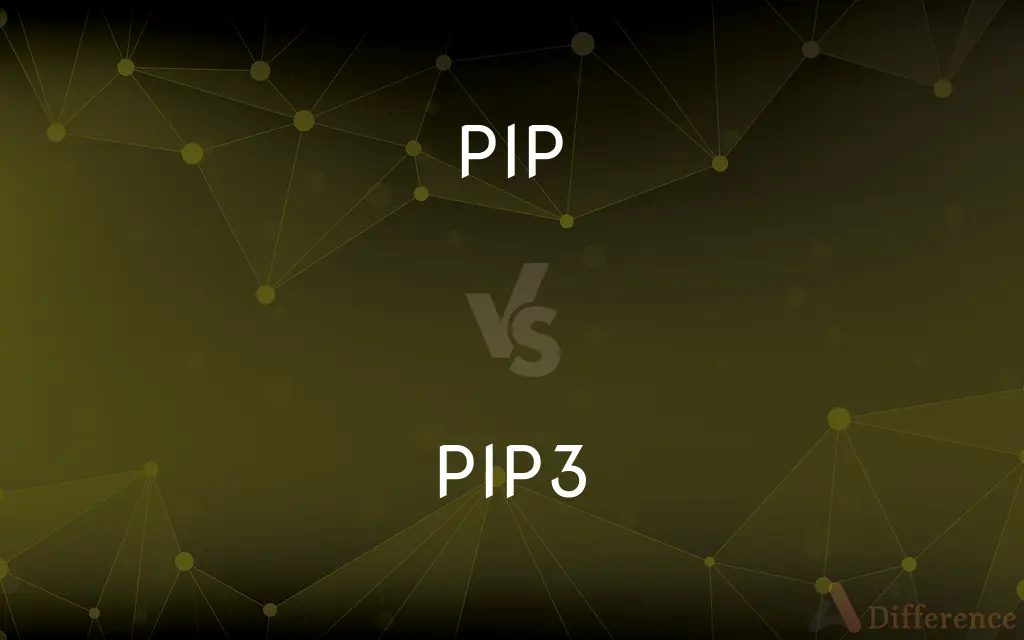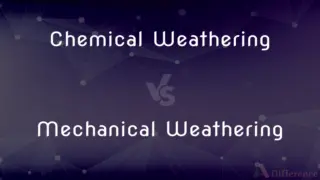PIP vs. PIP3 — What's the Difference?
Edited by Tayyaba Rehman — By Fiza Rafique — Published on December 7, 2023
PIP, or Phosphatidylinositol phosphate, is a membrane phospholipid; PIP3, or Phosphatidylinositol (3,4,5)-trisphosphate, is its phosphorylated form crucial in cell signaling.

Difference Between PIP and PIP3
Table of Contents
ADVERTISEMENT
Key Differences
PIP and PIP3 are both phospholipids, with PIP acting as a precursor. They play critical roles in cellular mechanisms, but their functions and locations differ. PIP, as a fundamental phospholipid, is present in cell membranes and can be converted to other phosphoinositides.
PIP3 is a product formed when PIP is phosphorylated at the third position of the inositol ring. This phosphorylation makes PIP3 unique and allows it to activate specific proteins, such as Akt, in cell signaling pathways.
PIP's conversion to PIP3 is a central step in various signaling cascades. The transformation requires the enzyme phosphoinositide 3-kinase (PI3K) for PIP3 generation, whereas the enzyme PTEN dephosphorylates PIP3 back to PIP.
The balance between PIP and PIP3 in a cell is vital. This equilibrium determines cellular decisions like growth, survival, or apoptosis. The dysregulation between PIP and PIP3 is linked with diseases like cancer.
Both PIP and PIP3 are part of a larger phosphoinositide family. Their levels, localization, and functions in cells are strictly regulated by various enzymes, ensuring proper cellular functions and responses to external stimuli.
ADVERTISEMENT
Comparison Chart
Chemical Structure
Phosphatidylinositol phosphate.
Phosphorylated form of PIP at the 3rd position of the inositol ring.
Function
Acts as a precursor to other phosphoinositides.
Plays a key role in activating specific proteins in cell signaling.
Enzymatic Regulation
Can be phosphorylated by PI3K to form PIP3.
Can be dephosphorylated by PTEN to revert back to PIP.
Associated Diseases
Imbalances can lead to diseases, but not as directly as PIP3.
Dysregulation linked directly to diseases like cancer.
Role in Cell Signaling
Primarily acts as a substrate for the formation of other signaling lipids.
Directly activates proteins like Akt in cellular signaling pathways.
Compare with Definitions
PIP
The small seed of a fruit, as that of an apple or orange.
PIP3
Central in numerous cell signaling pathways.
PIP3's presence is a marker of activated PI3K signaling.
PIP
A dot indicating a unit of numerical value on dice or dominoes.
PIP3
A product of the enzyme PI3K acting on PIP.
PI3K is responsible for the conversion of PIP to PIP3.
PIP
A mark indicating the suit or numerical value of a playing card.
PIP3
Its levels are tightly regulated in cells.
An overproduction of PIP3 is often seen in malignant cells.
PIP
A spot or speck.
PIP3
A phosphorylated form of PIP.
PIP3 activation leads to the recruitment of Akt to the membrane.
PIP
A rootstock of certain flowering plants, especially the lily of the valley.
PIP3
Direct activator of several intracellular proteins.
Upon formation, PIP3 rapidly activates downstream effectors.
PIP
Any of the small segments that make up the surface of a pineapple.
PIP
(Informal) A shoulder insignia indicating the rank of certain officers, as in the British Army.
PIP
See blip.
PIP
A short, high-pitched radio signal.
PIP
A disease of birds, characterized by a thick mucous discharge that forms a crust in the mouth and throat.
PIP
(Slang) A minor unspecified human ailment.
PIP
To wound or kill with a bullet.
PIP
To defeat.
PIP
To blackball.
PIP
To break through (the shell) in hatching. Used chiefly of birds.
PIP
To peep or chirp.
PIP
Any of various respiratory diseases in birds, especially infectious coryza.
PIP
Of humans, a disease, malaise or depression.
PIP
(obsolete) A pippin, seed of any kind.
PIP
(UK) A seed inside certain fleshy fruits (compare stone/pit), such as a peach, orange, or apple.
Apple pips are edible, but don't have a pleasant taste.
PIP
Something or someone excellent, of high quality.
PIP
P in RAF phonetic alphabet.
PIP
One of the spots or symbols on a playing card, domino, die, etc.
PIP
One of the stylised version of the Bath star worn on the shoulder of a uniform to denote rank, e.g. of a soldier or a fireman.
PIP
A spot; a speck.
PIP
A spot of light or an inverted V indicative of a return of radar waves reflected from an object; a blip.
PIP
A piece of rhizome with a dormant shoot of the lily of the valley plant, used for propagation
PIP
One of a series of very short, electronically produced tones, used, for example, to count down the final few seconds before a given time or to indicate that a caller using a payphone needs to make further payment to continue the call.
PIP
The smallest price increment between two currencies in foreign exchange (forex) trading.
PIP
(transitive) To remove the pips from.
Peel and pip the grapes.
PIP
To get the better of; to defeat by a narrow margin
He led throughout the race but was pipped at the post.
PIP
To hit with a gunshot
The hunter managed to pip three ducks from his blind.
PIP
To peep, to chirp
PIP
(avian biology) To make the initial hole during the process of hatching from an egg
PIP
A contagious disease of fowls, characterized by hoarseness, discharge from the nostrils and eyes, and an accumulation of mucus in the mouth, forming a "scale" on the tongue. By some the term pip is restricted to this last symptom, the disease being called roup by them.
PIP
A seed, as of an apple or orange.
PIP
One of the conventional figures or "spots" on playing cards, dominoes, etc.
PIP
To cry or chirp, as a chicken; to peep.
To hear the chick pip and cry in the egg.
PIP
A disease of poultry
PIP
A minor nonspecific ailment
PIP
A small hard seed found in some fruits
PIP
A mark on a playing card (shape depending on the suit)
PIP
A radar echo displayed so as to show the position of a reflecting surface
PIP
Kill by firing a missile
PIP
Hit with a missile from a weapon
PIP
Defeat thoroughly;
He mopped up the floor with his opponents
PIP
A phospholipid found in cell membranes.
PIP can be phosphorylated to form other signaling molecules.
PIP
Precursor to several vital cellular signaling lipids.
From PIP, various phosphoinositides can be derived.
PIP
A substrate for the enzyme PI3K.
PI3K converts PIP to PIP3, initiating several cell responses.
PIP
Represents the monophosphorylated form of phosphatidylinositol.
PIP has a phosphate group attached to its inositol ring.
PIP
Crucial in the regulation of cell function.
Alterations in PIP levels can impact cellular growth and survival.
Common Curiosities
Are PIP and PIP3 the same molecule?
No, PIP3 is a phosphorylated version of PIP.
What enzyme converts PIP to PIP3?
The enzyme phosphoinositide 3-kinase (PI3K).
Can PIP3 revert back to PIP?
Yes, through the action of the enzyme PTEN.
Do PIP and PIP3 interact with proteins?
Yes, both interact with proteins, but PIP3 has a more direct activating role.
Can imbalances in PIP and PIP3 lead to health issues?
Yes, especially imbalances in PIP3 are linked to diseases like cancer.
Are PIP and PIP3 the only phosphoinositides in cells?
No, they are part of a larger phosphoinositide family.
What's the main function of PIP3?
PIP3 activates specific proteins in cell signaling, like Akt.
Which molecule has more phosphate groups?
PIP3 has more than PIP.
Why are PIP and PIP3 important in medicine?
Dysregulation of their levels can lead to diseases, including cancer.
How is PIP3's role different in cell signaling?
PIP3 directly activates proteins, while PIP is a precursor.
Are both PIP and PIP3 present in all cells?
They are widely distributed, but levels vary depending on cell type and state.
Is the formation of PIP3 a reversible process?
Yes, PTEN can dephosphorylate PIP3 to PIP.
How do cells regulate PIP3 levels?
Through a balance of enzymes like PI3K and PTEN.
Do PIP and PIP3 play roles in cellular metabolism?
Yes, especially PIP3 is central to metabolic signaling pathways.
How does PIP3 affect protein localization in a cell?
PIP3 recruits and activates proteins at the cell membrane where it's located.
Share Your Discovery

Previous Comparison
Chemical Weathering vs. Mechanical Weathering
Next Comparison
Point Elasticity vs. Arc ElasticityAuthor Spotlight
Written by
Fiza RafiqueFiza Rafique is a skilled content writer at AskDifference.com, where she meticulously refines and enhances written pieces. Drawing from her vast editorial expertise, Fiza ensures clarity, accuracy, and precision in every article. Passionate about language, she continually seeks to elevate the quality of content for readers worldwide.
Edited by
Tayyaba RehmanTayyaba Rehman is a distinguished writer, currently serving as a primary contributor to askdifference.com. As a researcher in semantics and etymology, Tayyaba's passion for the complexity of languages and their distinctions has found a perfect home on the platform. Tayyaba delves into the intricacies of language, distinguishing between commonly confused words and phrases, thereby providing clarity for readers worldwide.











































